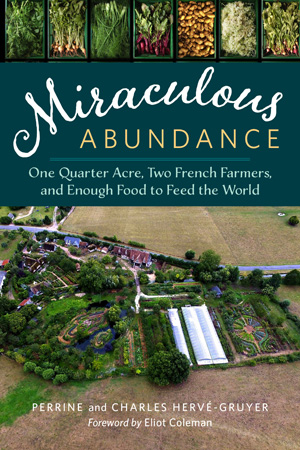 Reviewed by Andrew Mefferd
Reviewed by Andrew Mefferd
Two new books show the positive impact that permaculture techniques can have when combined with market farming. Miraculous Abundance is the story of two French farmers who set out to see how much food they could grow, and whether they could support themselves solely through farming on a quarter acre. As Eliot Coleman says in his foreword to the book, “...La Ferme du Bec Hellouin is the finest example I have seen of truly commercial permaculture/market gardening...it is like a United Nations of all the best sustainable farming ideas.”
Authors Perrine and Charles Herve-Gruyer bring an inventiveness to farming, including borrowing from native cultures and permaculture in demonstrating that it’s not the size of the farm that determines whether you can make a living or not. With techniques like chicken coops inside of greenhouses, with plantings on top of the coops so no growing space is wasted, they take a maximalist approach to a minimal amount of space. Their farm is designed as an example of “Biointensive Microagriculture,” and a vision of the role small farms can play in a thriving agricultural landscape. This book refutes the “get big or get out” philosophy of agriculture by showing a future where small farms have an important role to play in growing food, sequestering carbon, creating jobs and increasing biodiversity without relying on fossil fuels. The ideas are equally applicable to urban, suburban and rural farms. Both a fascinating personal story and a quest, Miraculous Abundance is an inspiration for those of us looking to be as productive and sustainable as possible. Purchase now in our store.
Shawn Jadrnicek’s new book, The Bio-Integrated Farm, is extremely practical. The author uses a unique permaculture-based system to tie the physical elements of farms together and make them more efficient by harnessing the free powers of nature through design.
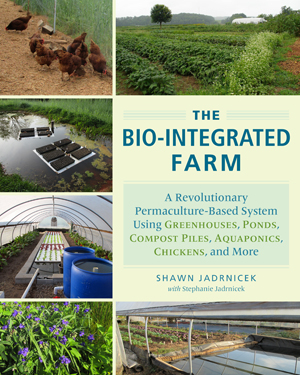 You do not have to be into permaculture to get into this book. It is not a permaculture guide; it will not teach you how to do permaculture. It will show you how to integrate aspects of permaculture into your farm landscape, and work with the forces of nature as much as possible in the process. What I like about the book is that it brings permaculture type improvements to features that already exist on market farms: fields, ponds, greenhouses, chicken coops, etc. Jadrnicek has been a farmer, nursery grower, extension agent, landscaper and is currently the manager of the Student Organic Farm at Clemson University in South Carolina. He brings the experiences from all these related fields to bear on improving farm design.
You do not have to be into permaculture to get into this book. It is not a permaculture guide; it will not teach you how to do permaculture. It will show you how to integrate aspects of permaculture into your farm landscape, and work with the forces of nature as much as possible in the process. What I like about the book is that it brings permaculture type improvements to features that already exist on market farms: fields, ponds, greenhouses, chicken coops, etc. Jadrnicek has been a farmer, nursery grower, extension agent, landscaper and is currently the manager of the Student Organic Farm at Clemson University in South Carolina. He brings the experiences from all these related fields to bear on improving farm design.
Jadrnicek doesn’t look at the design features of a farm as separate units, but sees how they integrate with the whole to equal more than the sum of their parts. For example, building a greenhouse could be seen as a drainage problem, shedding rain off the structure, saturating the surrounding area. To Jadrnicek’s thinking, with some planning the greenhouse could serve as a catchment for a pond to provide irrigation and heating or cooling for the greenhouse, fertility, chicken feed, reflect light into the greenhouse, and several other possible functions. One of the principles of the book is stacking, trying to maximize the number of functions of every feature on the farm.
Multi-functionality is not a foreign concept for farmers, but Jadrnicek’s methods will be new to most people. There is a lot of original thinking in this book. He integrates some of the most rudimentary agricultural features (like basins) with very modern ones (like greenhouses). There are some great ideas on how to build a greenhouse on a slope, build a pond inside a greenhouse, and integrate aquaculture and aquaponics into greenhouse projects.
This book is great for the do-it-yourselfer and is scalable. For most of the projects, you don’t have to buy specialized equipment, and what you do have to buy is probably on the shelf at your local hardware store.
The Bio-Integrated Farm is a must-read for anyone planning infrastructure projects on the farm. As far as answering the question posed in Miraculous Abundance, Jadrnicek’s designs have a role to play in keeping the environmental as well as the economic bottom lines as strong as possible on farms of all sizes. Purchase now in our store.
Miraculous Abundance is available for $24.95, The Bio-Integrated Farm is available for $39.95, plus $5 shipping, from growingformarket.com. Subscribers get a 20% discount. Or phone 800-307-8949.

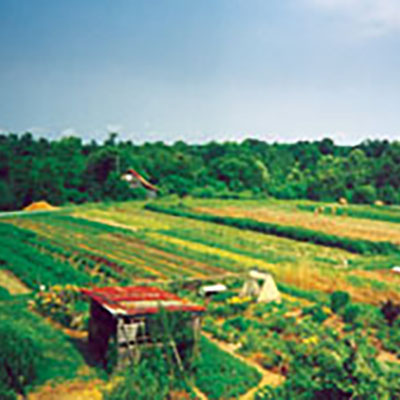
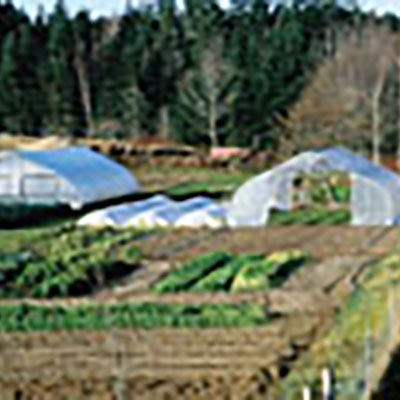


 Farmer to Farmer Profile
Farmer to Farmer Profile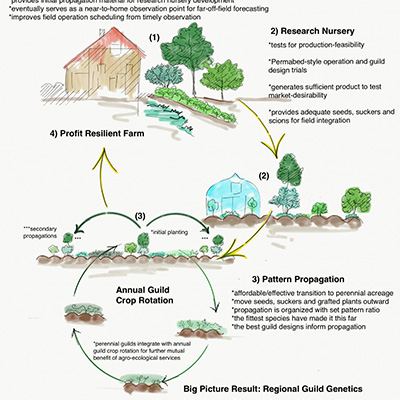
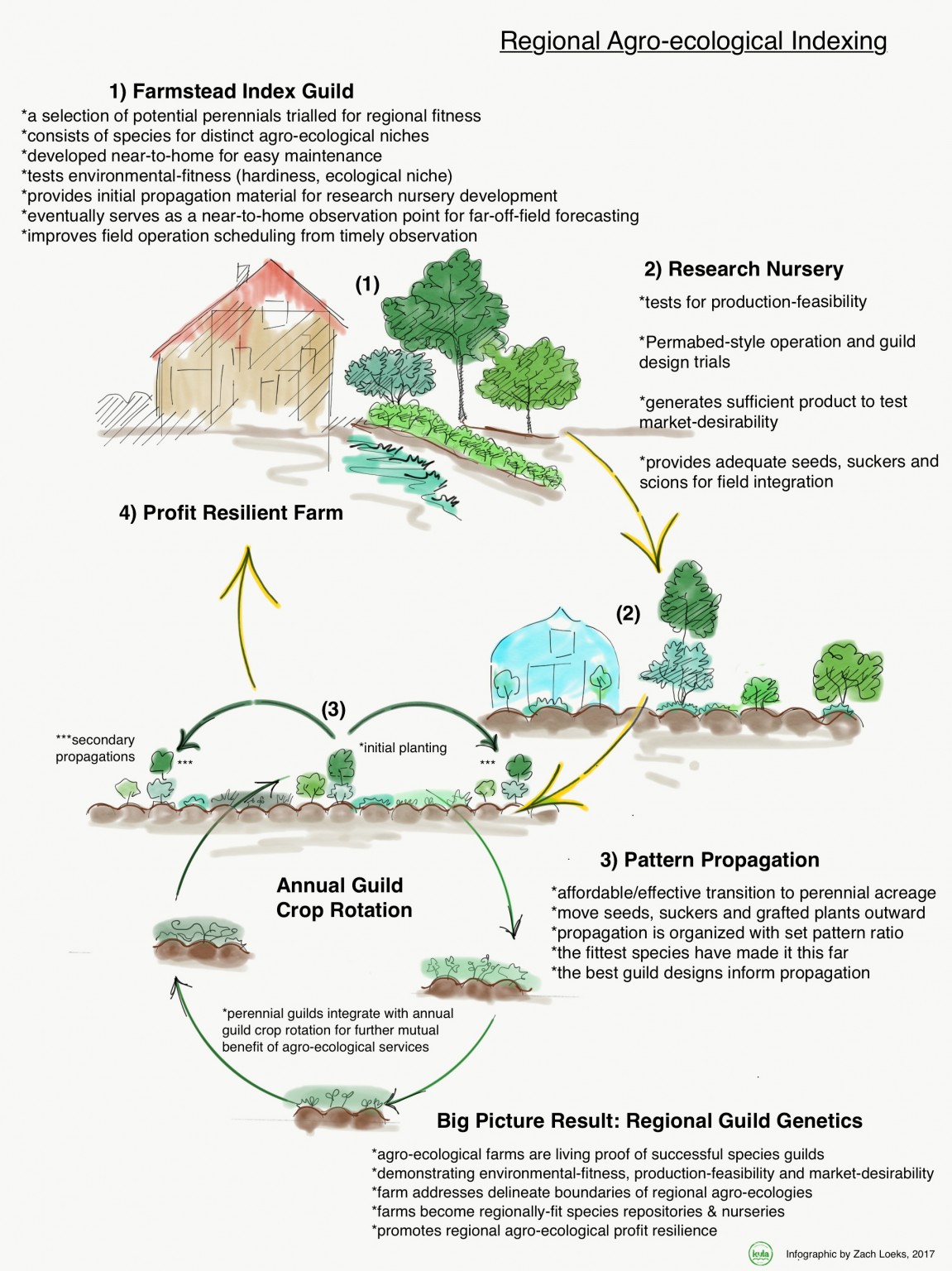
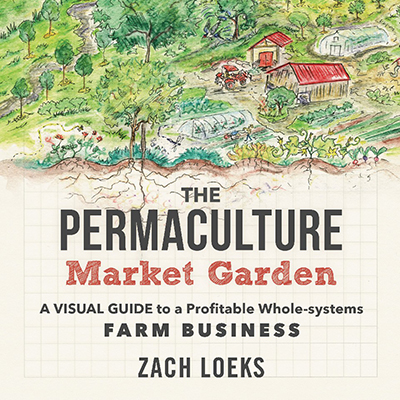
 This is the first of a two-part article about using permaculture techniques to improve the profitability and resiliency of market gardens.
This is the first of a two-part article about using permaculture techniques to improve the profitability and resiliency of market gardens. 

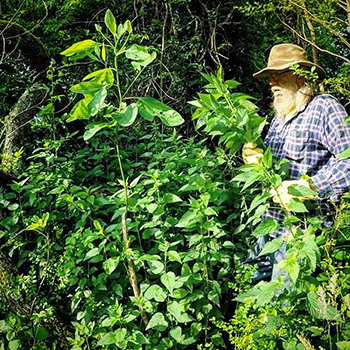 At Windy Hill Farm in Elk Creek, Virginia, Michelle Pridgen’s main crops are winter and spring high tunnel greens, along with tomatoes, peppers and flowers. Years ago, she went into the woods on the property to move some black cohosh (Actaea racemosa) into an ornamental perennial border but never considered it a cash crop. Then, a Virginia Tech doctoral student persuaded her to participate in a trial to prove certified sustainable forest crops fetch much higher prices than wild harvested plants like cohosh that are losing habitat and are over harvested.
At Windy Hill Farm in Elk Creek, Virginia, Michelle Pridgen’s main crops are winter and spring high tunnel greens, along with tomatoes, peppers and flowers. Years ago, she went into the woods on the property to move some black cohosh (Actaea racemosa) into an ornamental perennial border but never considered it a cash crop. Then, a Virginia Tech doctoral student persuaded her to participate in a trial to prove certified sustainable forest crops fetch much higher prices than wild harvested plants like cohosh that are losing habitat and are over harvested.
 Most flower farms evolve and change in their early years — adopting crops, markets and niches and shedding crops, markets and niches based on viability, preferences and motivation. Danielle Schami of Les fleurs Franktown House Flowers in Wakefield, Quebec, has navigated various paths during her seven years farming. Today, her focus is strengthening her region’s local flower movement and building partnerships.
Most flower farms evolve and change in their early years — adopting crops, markets and niches and shedding crops, markets and niches based on viability, preferences and motivation. Danielle Schami of Les fleurs Franktown House Flowers in Wakefield, Quebec, has navigated various paths during her seven years farming. Today, her focus is strengthening her region’s local flower movement and building partnerships.